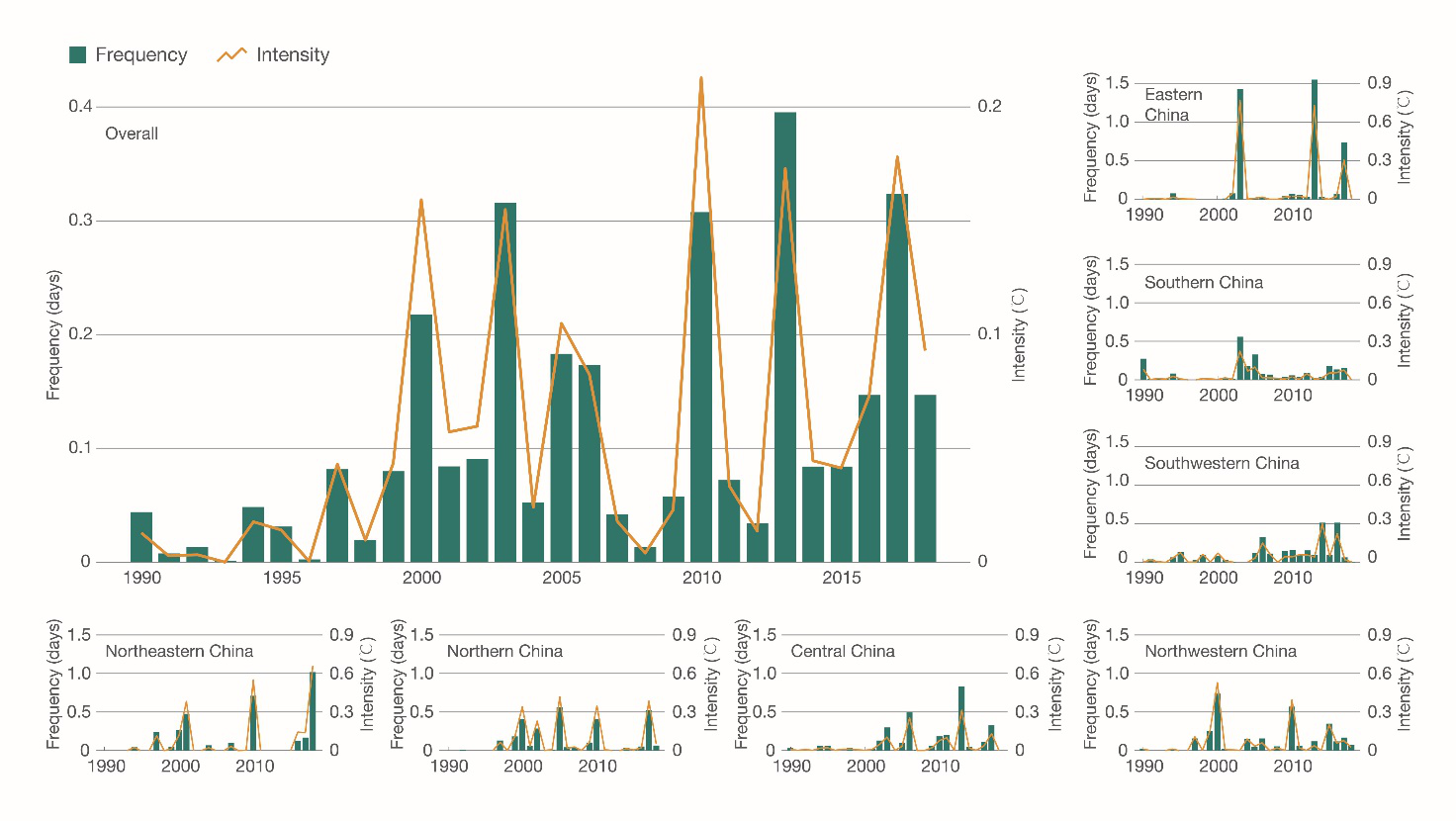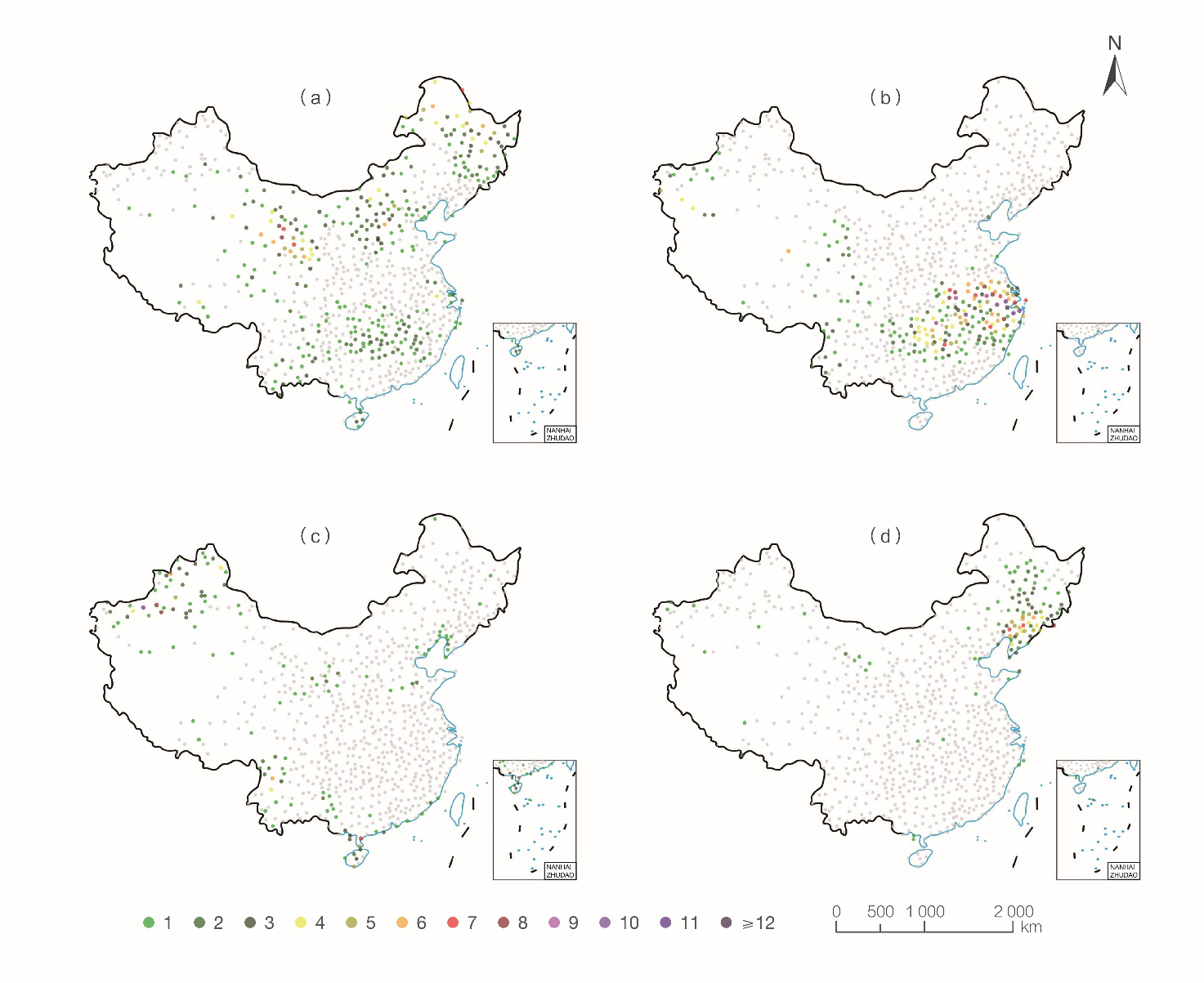SDG13: Climate Action
Intensity and frequency of extreme high-temperature events and heatwaves in China(2020)
Target: 13.1 Strengthen resilience and adaptive capacity to climate-related hazards and natural disasters in all countries.
| Highlights |
| The spatiotemporal changes in the intensity and frequency of extreme high-temperature events and heatwaves in China are assessed over the 1990-2018 timeframe, based on homogenized temperature series data from 754 terrestrial weather stations, pointing to significantly increased intensity and frequency of extreme high-temperature events and heatwaves in China since the late 1990s. |
Background
The central aim of the Paris Agreement is "to strengthen the global response to the threat of climate change by keeping a global temperature rise this century well below 2 degrees Celsius above pre-industrial levels and to pursue efforts to limit the temperature increase even further to 1.5 degrees Celsius". Extreme high-temperature events and heatwaves have become some of the predominant climate-related disasters ravaging China in recent decades.
In this study, we introduce the notion of "dynamic reoccurrence periods" to further refine the indicators of extreme high-temperature events and heatwaves and expand the scope of their application. They are particularly serviceable in describing extreme high-temperature events and heatwaves that have occurred in recent years. Characterization of the spatiotemporal evolution of extreme high-temperature events enables an accurate and holistic understanding of the pattern of extreme high-temperature events and heatwaves in China, to provide science-informed support for policy-making under relevant SDGs.
Data used
Daily maximum temperature series data from 754 stations from 1960 to 2018 compiled and published by the Information Center of the China Meteorological Administration, adjusted and homogenized (Li et al., 2015). The baseline period is 1979-2018.
Method
Homogenization of data minimizes the systematic deviations resulting from relocation of stations or changes in observational methods and techniques. The highest values of daily maximum temperatures in the summer half-year (April through September) captured at all stations are used to work out periods and levels of recurrence through Generalized Extreme Values (GEV) fitting. Dynamic reoccurrence periods are computed with a linear model in time using location parameters, from which the annual frequency of "once-in-N-year" extreme high-temperature events is worked out for each station. A "once-in-N-year" extreme high-temperature event is one where the probability of the year's maximum temperature reaching or exceeding a given recurrence threshold under the climatic conditions of the current year is 1/N. Hence the average yearly frequency of extreme high-temperature events at every station across China and in each of the seven regions can be calculated. The intensity of an extreme high-temperature event is expressed as a temperature value (in Celsius) in excess of a given "once-in-N-year" level of recurrence.
Results and analysis
The frequency of "once-in-20-year" extreme high-temperature events in China has markedly increased since the late 1990s (Fig. 1). Since 2000, five years, i.e. 2000, 2003, 2010, 2013 and 2017, were marked by an unusually high incidence of extreme high-temperature events and heatwaves. In each of those five years, notable extreme high-temperature events and heatwaves happened in two or three of the seven climatic regions of China, with marked variations in both frequency and intensity from year to year. As a general trend, each region is hit by an unusually high incidence of extreme high-temperature events and heatwaves once every five to ten years. The intensity of extreme high-temperature events and heatwaves in northern regions is relatively higher than that in southern regions.

Figure 1. The average frequency and intensity of "once-in-20-year" extreme high-temperature events and heatwaves across China and in each region, 1990-2018
Notable extreme high-temperature events and heatwaves have been observed almost every year since 2010 (Fig. 2). The most spatially extensive extreme high-temperature events and heatwaves happened in 2010 when more than half of the regions across China recorded extreme high-temperature events. The intensity of extreme high-temperature events and heatwaves peaked in 2013 when dozens of stations in central and eastern China recorded around 10 days of extreme high temperatures. In 2016 and 2017, extreme high-temperature events and heatwaves also affected many parts of China. Worth noting is the high incidence of relatively defined extreme high-temperature events and heatwaves in some high-latitude or high-altitude areas in recent years. A record fifteen-day spell of extreme high temperatures hit a mountainous area in southwestern China in 2014. Similarly, in 2010, 2015 and 2018, eight to ten days of extreme high temperatures were recorded at some high-altitude and high-latitude stations, topping the rest of the country for that year in each case.

Figure 2. The spatial pattern of "once-in-5-year" extreme high-temperature events and heatwaves in 2010 (a); 2013 (b); 2015 (c) and 2018 (d). Grey dots indicate stations with no recorded extremes (Note: no data available for Taiwan province).
Outlook
This study enables a better understanding of extreme high-temperature events and heatwaves through the lens of recurrence periods and levels by modifying the criteria of their definitions. There has been a persistently high incidence of extreme high-temperature events and heatwaves across China in recent years, so much so that they have become routine occurrences – approaching or reaching record high temperatures in approximately one third of regions in China every five years or so since 2000. This trend has been more pronounced in recent years, with extensive or highly intense heatwaves each and every year. It is therefore necessary to better forecast overall climate and weather conditions associated with extreme high-temperature events and build greater capacity for holistic planning to respond to extreme high-temperature events and heatwaves of disastrous proportions in different regions. Furthermore, enhanced monitoring and forecasts are required for relatively defined heatwaves in high-latitude and high-altitude areas. Excessive heat in absolute terms is rare in these areas, hence the tendency to overlook them in the past. Yet, in recent years, relatively defined extreme high-temperature events and heatwaves in these areas have occurred more frequently than in central and eastern parts of China known for a high incidence of classic heatwaves, posing an equally grave threat to local agricultural and forest ecosystems and infrastructure.
Alongside China's rapid socioeconomic development over the recent decades, there has been a huge influx of population into large and medium-sized cities, as well as sea change to land uses. An important question to explore and answer going forward is how to assess, with greater precision, the impacts of extreme high-temperature events and heatwaves on productive activities, daily life, physical health and natural ecosystems by leveraging demographic, land and other Big Earth Data and factoring in the exposures and vulnerabilities of different communities and systems.

